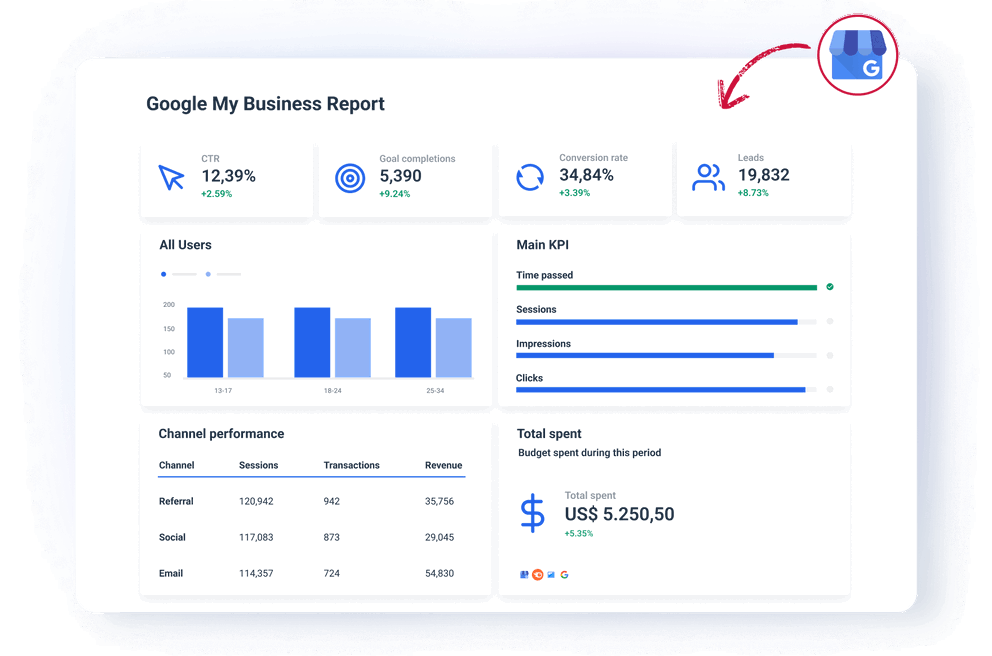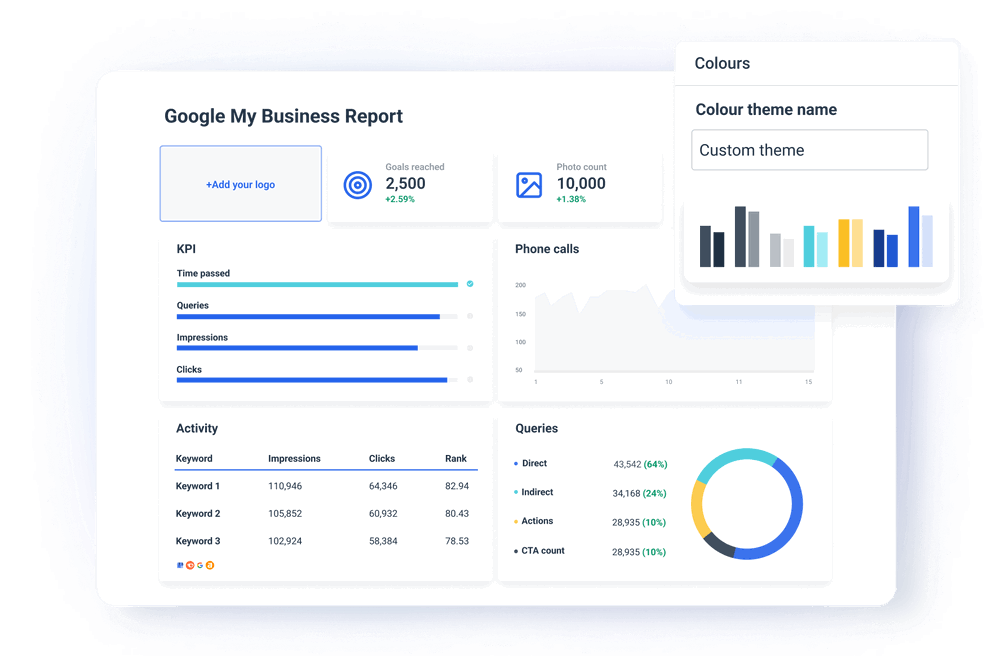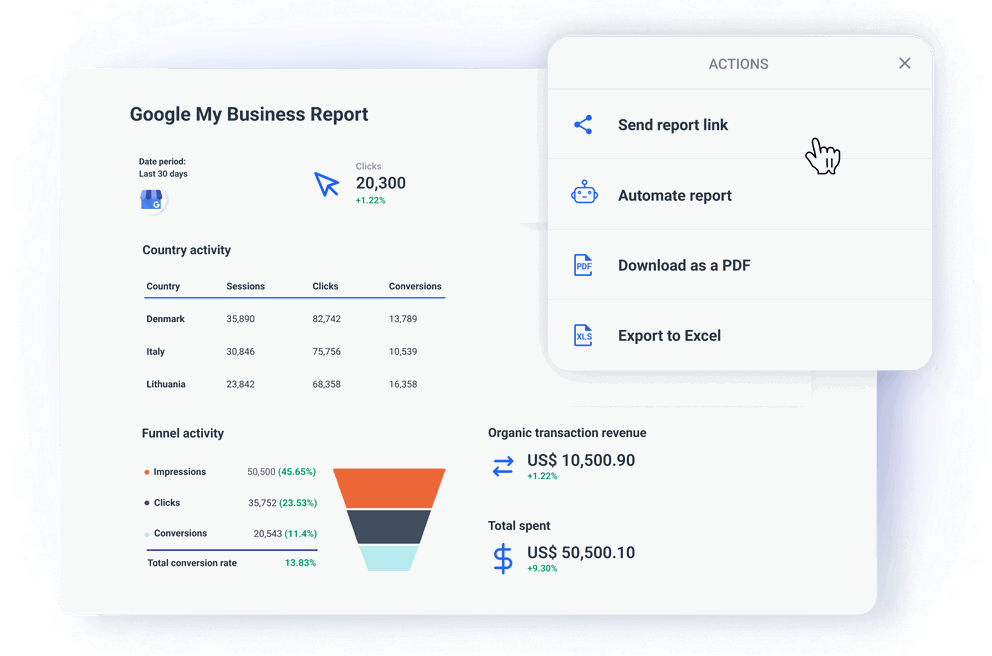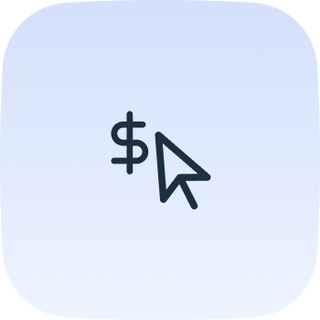Why Do You Need a GMB Report for Local SEO?
A Google My Business (GMB) report is an essential tool for any business or marketing agency focused on local SEO.
It gives clear, actionable insights into:
- How the business is performing in local search results.
- How customers are interacting with the business profile.
- What improvements you need to make to improve visibility and engagement.
Here are four more reasons why a GMB report is important for improving local SEO:
1. Tracking local search performance
A GMB report lets you track the key performance metrics such as:
- Search Impressions: How often a business listing appears in local search results.
- Search Queries: The specific keywords people use to find your business. This helps you optimize the content and services to match local search intent.
- Views and Clicks: How many views a listing gets and how often users click to call, visit the website, or ask for directions.
2. Understanding customer behavior
A Google My Business report shows you how customers interact with your client’s listing by giving you data on:
- Phone Calls: The number of calls coming directly from the client’s GMB listing.
- Direction Requests: How often customers request directions to your business.
- Website Visits: Click-throughs from your GMB profile to your website.
Customer behavior metrics are important for refining your client’s local GMB strategy.

If people don’t click to your client’s website or don’t call, you can optimize the client’s business profile by adding better CTAs, updating business information, or including special offers.
3. Improve local rankings with better GMB optimization
A GMB report provides insights that help you make data-driven decisions to improve the local SEO for your clients.
What does this include?
- Listing Completeness: Make sure the client’s business profile is 100% filled out. This includes services, hours of operation, and photos. A complete profile can improve your ranking in local searches.
- Review Management: The clients can track customer reviews and respond to them promptly. Google values customer interaction and positive reviews as ranking factors.
- Posts and Updates: GMB post insights can tell you what kind of content your audience prefers so you can create more engaging updates.
By regularly reviewing this data, you can spot areas to improve your GMB profile, which will positively impact your local search rankings.
4. Monitor business growth and ROI
Finally, a Google My Business report give you valuable data to:
- Measure ROI: Calculate the value of your SEO efforts by connecting traffic and customer actions to business outcomes like phone calls or sales.
- Track growth trends: Review monthly, quarterly, or yearly performance to identify growth patterns.
More website clicks, views, and calls over time is a clear sign that your local SEO efforts are working. Although these are simple metrics, they are important for understanding the long-term success of your local SEO strategy.
What Are the Challenges of Effective Reporting?
As an agency, you want to report on a client’s local search performance metrics effectively and at scale.
In other words, you need a quick and efficient way to collect, analyze, and present Google My Business data. However, there are some challenges you need to overcome:
- Time: You don’t want to spend too much time creating complex reports. You need a solution that makes the process simple—and pretty much automated!
- Data accuracy: You want to make sure that the template always pulls in accurate real-time data from Google My Business.
- Flexibility: Your marketing report template needs to cater to the needs of different clients. You should be able to easily change it for the next client, add custom branding or focus on different performance metrics.
- Technical difficulties: You don’t want a reporting solution that will be difficult to learn or need technical expertise to set up or maintain. Ideally, any account executive in your agency should use it with minimal training.
A capable GMB reporting solution allows you to:
- Track the performance of your Google My Business listing.
- Present insights in a professional format that is understandable to clients.
- Save time by using a pre-made template instead of creating reports from scratch.
Your audience is small business owners.
They may not have the resources or technical skills to build detailed reports. They want you to create simple reports to help them understand how their business performs locally on Google.
How to Choose the Best Google My Business Reporting Solution?
There are many GMB report template tools out there. Some of those just give you the bare frame to fill in the data you export manually.
Others are created for third-party tools such as Google Data Studio. In that case you need to switch between two platforms to get the job done.
But you’re not interested in those.
You need a plug-and-play GMB reporting tool. One that will help you create stunning automated reports in a few minutes.
Let’s help you narrow down your search.
You know you’ve found what you’re looking for if your report template is:
1. Easy to set up and use
For agencies, time is money.
A Google My Business reporting tool that's easy to use means less time spent on figuring out complex software and more time delivering results for clients (and onboarding new ones!).
Look for software that lets you:
- Set up automated marketing data connections that refresh in real time (no maintenance needed)
- Rearrange or add new widgets, graphs, and charts using drag-and-drop
- Customize each report for specific client ( without coding or design skills)
- Create any report you want within minutes with little or no training
- Automate the report sending on a schedule that fits the client
A good GMB reporting tool effectively puts your reporting process on autopilot. You can use it to create engaging reports in less than an hour without having to list help from developers, graphic designers, or data engineers.
And when a template is easy to use, it’s also easier and faster to onboard new members and clients. Plus, you can use the time saved for more creative and billable tasks.
2. Highly customizable
Different clients have different optimization goals. This means the Google My Business reporting tool you choose must allow you to choose which key metrics to highlight in your reports.
In Whatagraph, for example, this is very easy to do using drag and drop metrics widgets. All metrics from your GMB account are available as single-value widgets, graphs, charts, or tables.
Anyone on your team can easily build reports without hiring a data scientist.
On the visual side, you can:
- Upload your logo or client’s logo to the report
- Create color schemes that match your or your client brand colors
- Add text, headers, and footers
- Create more tabs to organize your report into sections
In other words, you can do everything to create a professional-looking white-label report without assigning complex set ups across your team.
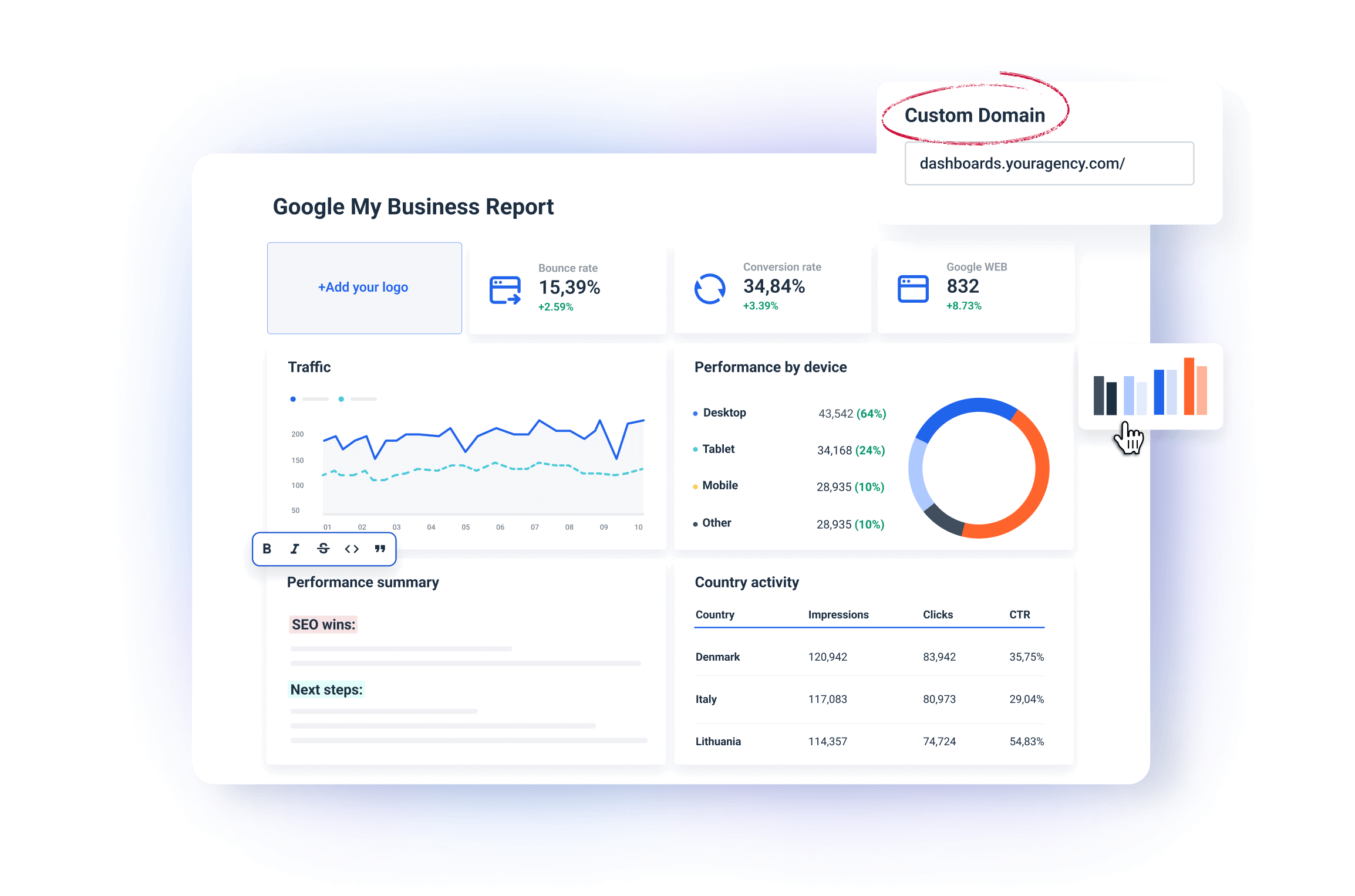
3. Easy to integrate data from other platforms
A client may hire your expertise to help them boost their visibility on local searches and call it a day. This is fine, but more often than not, they are interested in monitoring their overall organic search performance, website optimization, social leads, etc.
So your template tool should easily integrate data from sources like:
- Google Analytics
- Google Search Console
- Ahrefs
- Semrush
- SE Monitor
- SERanking
- AccuRanker
But are you going to create separate reports for all these channels?
That would take so much time!
On Whatagraph, you can easily add data from any source you have to any report template and organize it in logical sections or tabs. And every integration refreshes automatically so you only need to send one report for each client.
4. Stable and reliable
As an old saying goes, “Don’t judge a report template by the number of integrations”. Having more data connectors is great. But it’s also important that these connections are stable and reliable.
This means that they won’t break off in the middle of a client demo call or half an hour before the client’s internal meeting, making the report unusable until the problem is resolved.
Many reporting tools use third-party connections to pull data, which is not the ideal way. The connection speed may vary between individual vendors, and there are other issues such as
- API limitations and changes
- Data compatibility issues
- Rate limits
- Authentication problems
- Network and latency issues
Whatagraph integrations are all in-house built and fully managed. There’s nothing to set up on your side. They are all maintained and updated by our dedicated Engineering team.
We build them to be plug-and-play. To pull data automatically from your platform accounts reliably and accurately.
You can also create a blend of different sources with custom metrics and dimensions. Add this blend as a source to your template — alongside any other “regular” data sources.
When your integrations are made in-house, the Engineering team can resolve any bugs much faster than if you go through a third-party company.
Why Should You Combine GMB Data With Other Marketing Metrics?
Combining Google My Business data with metrics from other marketing sources gives you a holistic view of your client’s business performance. These insights help you make more informed decisions.
Here’s why integrating GMB data with other platforms like Google Analytics, social media metrics, or paid advertising results can transform your marketing strategy.
1. Gain a comprehensive view of customer behavior
When you combine GMB data with metrics from Google Analytics or social media platforms, you can better understand how customers engage with your business on different touchpoints.
Let’s take two examples:
GMB Clicks vs. Website Traffic: Combining these two shows you how many users click on your website from your GMB listing. You can then track their behavior once they land on your site through Google Analytics.
This tells you whether GMB traffic is converting into leads or sales.
Search Queries & On-site Behavior: If you analyze GMB search queries side to side with Google Analytics data, you can tailor your landing pages to better match user intent.
By analyzing this data together, you can get a 360-degree view of your customer journey—from discovering your business in a local search to completing a purchase or visiting your store.
2. Improve local SEO & overall search strategy
GMB insights are essential for local SEO, but it’s only one piece of the puzzle. By combining GMB data with broader SEO metrics from tools like Google Search Console, you can:
- Compare GMB search queries with organic search queries: Understanding how local search queries differ from or complement organic search traffic helps you optimize both your local and overall SEO strategy.
- Track search performance holistically: Local businesses can see how they’re performing both locally (from GMB data) and organic search results (via Search Console).
This allows you to better optimize the content, keywords, and boost the overall visibility in both areas.
By connecting these insights, you’ll know which search terms drive foot traffic and which ones lead to online conversions, helping you tailor your SEO efforts accordingly.
3. Optimize marketing ROI
A huge benefit of combining GMB data with PPC metrics (e.g., from Google Ads or Facebook Ads) is that you can:
- Measure the full customer journey: If you’re running local ads, you can also combine GMB Impressions and Clicks with ad performance metrics. This way, you can track how well your campaigns are driving foot traffic or calls to your business.
For example, after a user clicks on a Google ad, do they go any further and request directions or call your business via GMB?
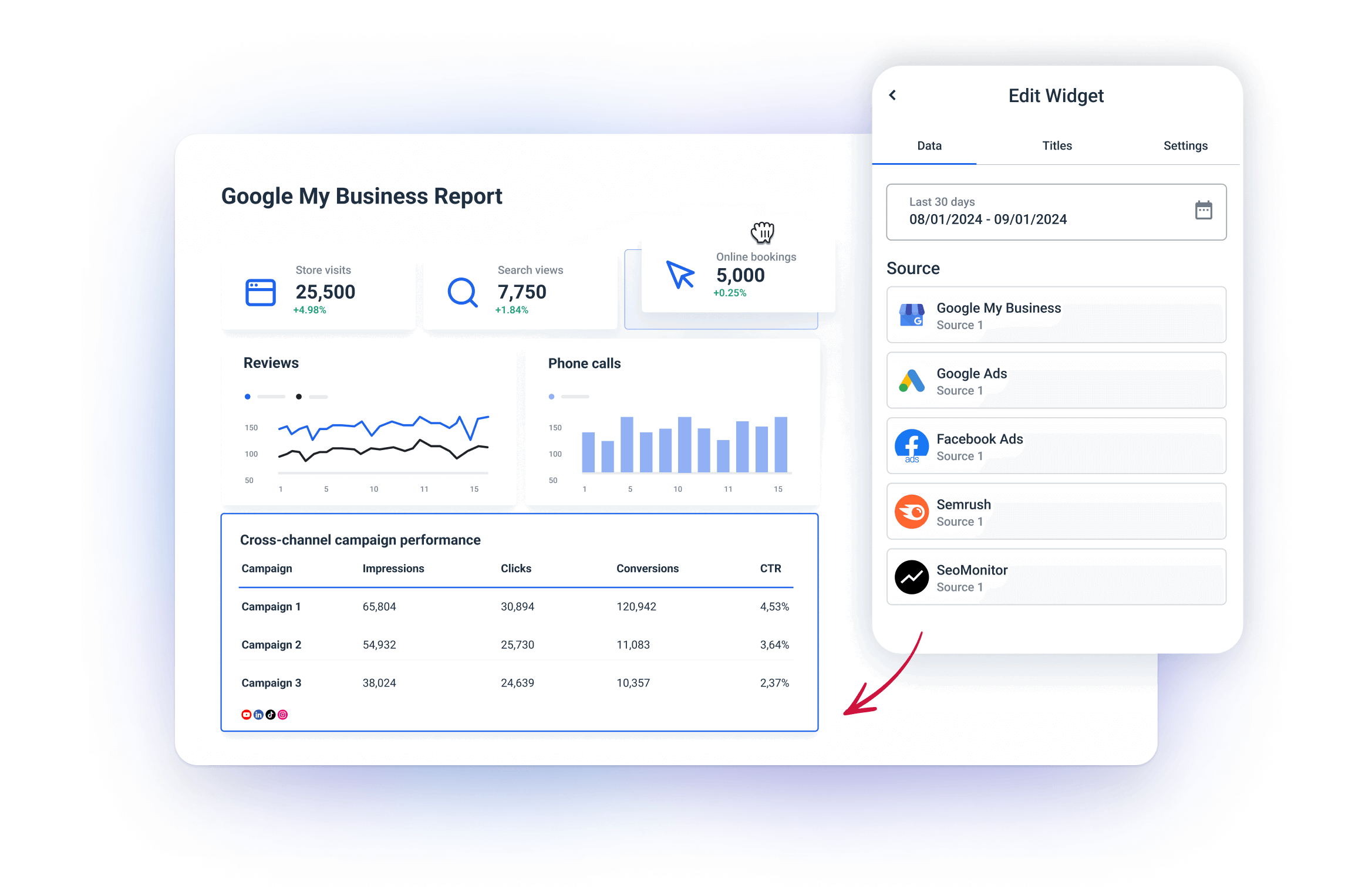
- Calculate conversion paths: By combining data from GMB and paid campaigns, you can see which marketing channels (paid search, organic, local) are driving the most conversions—whether it’s store visits, calls, or online bookings. This allows you to plan your budget to maximize ROI.
4. Make client reporting easier
Combining GMB data with metrics from various marketing channels (e.g., email marketing, social media engagement, paid ads) helps provide clients with a complete performance picture.
On the client reporting side, you can:
- Show the impact of local SEO on broader marketing efforts: Highlight how GMB listings drive local traffic while informing SEO, email, and social media strategies.
- Report cross-channel insights: Offering clients reports that include GMB data along with other channels. This will help them see how all parts of their marketing strategy are working together.
Such an integrated approach provides greater transparency and value to clients. It shows that their marketing efforts are driving real-world results across several channels.
5. Spot local marketing opportunities
By integrating GMB data with data from social media, email campaigns, or offline interactions, you can discover new opportunities for your client to engage with local customers:
- Event promotions: For example, if GMB insights show a surge in local interest during specific times or events, you can align this with social media promotions, email newsletters, or even paid ads.
- Cross-promotions: By analyzing foot traffic data from GMB alongside social engagement, you can identify when to push certain promotions, advertise events, or launch local offers.
This integration allows you to make data-driven decisions to optimize your local marketing efforts and take advantage of unique opportunities that attract the local audience.
6. Uncover actionable insights for local business growth
When you combine sales data (e.g., from your Salesforce, HubSpot or other CRM) with GMB insights such as reviews, calls, and direction requests, you can identify trends that directly lead to business growth:
- Sentiment and sales trends: Compare the sentiment from GMB reviews with your sales data. Positive reviews often relate to increased sales, while negative reviews can point to issues in customer service or product quality that you need to address.
- Store visits and sales data: Analyze how many people request directions to your store via GMB and compare this to actual sales numbers.
This way you can measure how effective your local marketing efforts are in driving foot traffic that converts into revenue.
How to Rank Higher on Local Searches – 5 Proven Tips
Here are five tips to help you boost your client’s local search ranking.
1. Get title and description tags in line
Title tags and description tags are the mini ads for your client’s business. They’re essential for grabbing attention and getting visitors to click on the website.
If Google “thinks” they are not good enough, it often rewrites them. Even worse, it can pick a less compelling line from your page.
So make sure that these two:
- Have acceptable length — 50-60 characters for title tags and 160-200 for description.
- Speak to your local audience
- Include the keyword—as close to the beginning
- Include the name of the city or are of your business
Use the space carefully and never waste it on words or names that don’t provide helpful information about your business page.
2. Optimize the Google Business Profile
If your client’s business qualifies for a GBP listing, you need to claim and optimize their Google Business Profile. The best thing about this strategy is that it’s completely free but can give a business an enormous exposure.
First, you need to claim your Google Business Profile. Go to google.com/business and go through the claiming and verification steps.
This is Google's way of deciding if you’re a legit real company. If you are doing this for a client, ask them to grant you permission to manage their Business Profile.
Next, you need to optimize and improve the GBP listing:
- Select categories
- Add business hours
- Write a good description
- Upload photos and videos
- Answer questions potential customers may ask
- Include the products the client sells
- Reply to customer reviews
- And more!
The Google Business Profile can give potential customers a lot of information about your client’s business. This is why it’s important to populate every relevant section to complete it.
3. Win positive reviews
Up to 84% of people trust online reviews as much as personal recommendations, according to BrightLocal’s 2023 Local Consumer Review Survey.
Online reviews—and especially 5-star reviews are extremely valuable for any local business. Your aim should be to get at least 10 5-star reviews on your Google Business Profile.
So, where should you focus on getting reviews?
Start with your Google Business Profile and your Facebook Page.
People often go to social media to see what their friends and family say about a business. This is why having good feedback on the business's Facebook page is important for attracting potential buyers.
Interestingly, sometimes third-party reviews even appear on your Google Business Profile.
Make sure to respond to every review, whether it’s positive or negative. This shows other people who read them that you (store owner) cares about what the customers think.
4. List your business in online directores
Online business directories (a.k.a. citations) like Yelp, Facebook, Merchant Circle, or Citysearch, often show high organic search results.
This is why it’s important to list your client’s business there as well. Fail to do so, and when a potential client clicks on those links in search results, they won’t find your business information.
Also, check with your local newspaper’s website and your local Chamber of Commerce to see if they have a local business directory you can get listed on.
One useful tactic is to search for keywords like “[your city] directory” to find other local citation sites or directories.
Finally, make sure to get your business name, address, and phone number (NAP) on the major citation data aggregators, like Foursquare, Data Axle, and Neustar Localeze.
These data aggregators distribute your company’s NAP to hundreds of online directories, so make sure the information is accurate and consistent.
5. Socialize!
Social media go hand in hand with your Google Business Profile. If you haven’t done so already, now it’s the time to add social media links to your client’s Business Profile.
You can add one social media profile for each of these platforms:
- X
- TikTok
- YouTube
And have you heard the good news?
Google recently started showing actual social media posts on GBPs!
Adding social media posts on your GBP listings helps build engagement on your Business Profile listing. And remember—Google values and rewards engagement!











